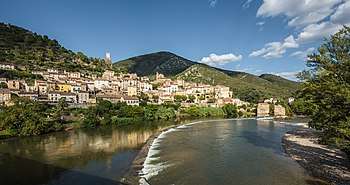Hérault
Hérault (French: [eʁo];[1] Occitan: Erau; [eˈɾaw]) is a department the Occitanie region of Southern France. Named after the Hérault River, its prefecture is Montpellier. It had a population of 1,132,481 in 2016.
Hérault | |
|---|---|
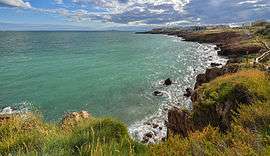   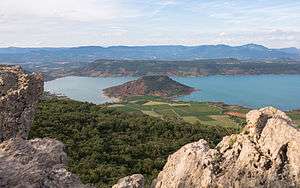 From top down, left to right: Mediterranean coast, Place de la Comédie in Montpellier, Béziers and Liausson's view of Salagou Lake | |
 Flag  Coat of arms | |
 Location of Hérault in France | |
| Coordinates: 43°21′N 3°13′E | |
| Country | France |
| Region | Occitanie |
| Prefecture | Montpellier |
| Subprefectures | Béziers Lodève |
| Government | |
| • President of the Departmental Council | Kléber Mesquida (PS) |
| Area | |
| • Total | 6,224 km2 (2,403 sq mi) |
| Population (2016) | |
| • Total | 1,132,481 |
| • Density | 180/km2 (470/sq mi) |
| Demonym(s) | Héraultais |
| Time zone | UTC+1 (CET) |
| • Summer (DST) | UTC+2 (CEST) |
| Department number | 34 |
| Arrondissements | 3 |
| Constituency | 7 |
| Cantons | 25 |
| Intercommunality | 16 |
| Communes | 342 |
| ^1 French Land Register data, which exclude estuaries, and lakes, ponds, and glaciers larger than 1 km2 | |
History
Hérault is one of the original 83 departments created during the French Revolution on 4 March 1790. It was created from part of the former province of Languedoc.
At the beginning of the 20th century, viticulture in the wine-growing region was devastated by a slump in sales combined with disease affecting the vines. Thousands of small scale producers revolted. This revolt was suppressed very harshly by the government of Georges Clemenceau.
The catastrophic frost of the winter of 1956 damaged the olive trees, and the olive-growing regions did not recover until the late 1980s. Many of the olive-industry co-ops closed.
During the second half of the twentieth century the Montpellier basin saw some of the most rapid population growth in France.[2]
Geography
Hérault is part of the region of Occitanie and is surrounded by the departments of Aude, Tarn, Aveyron, Gard, and the Mediterranean (Gulf of Lion) on the south. The department is geographically very diverse, with beaches in the south, the Cévennes mountains in the north, and agricultural land in between. To define the Hérault, one often tends to compare its territory to an open amphitheater facing the sea. The geography of the Hérault is marked by the diversity of its geology and its landscapes. These range from the southern foothills of the Massif Central, to the Mediterranean Sea, through the areas of garrigue and the low plain of Languedoc wine. The Hérault is bathed by a Mediterranean climate.
The minimum altitude is at sea level and the highest point of the department is at an altitude of 1181m in one of the peaks of Espinouse. The average altitude is about 227m.
The department of Hérault is crossed by several coastal rivers that originated in the southern foothills of the Massif Central to jump into the Mediterranean Sea after a course of general north-south orientation relatively short and high altitude. the main ones are from east to west the Vidourle, which marks the limit with the Gard department, the Lesz which crosses notably Montpellier, the Hérault, which gave its name to the department, and the Orb which waters Béziers. To the west, the Aude Valley, a 224 km river from the Pyrenees, whose course is oriented west-east, forms the limit with the department of the same name. These rivers as well as their tributaries are characterized by their regime, called "cévénol", marked by sudden variations of flow causing sudden and important floods. All along the coast of Herault successive lagoon, some of which have a large area, the largest of which is the Étang de Thau with an area of about 7,500 hectares.
The hinterland of the lowlands of Bas-Languedoc is gradually hilly. It is the territory of the vineyard, olive groves, orchards and scrubland. Olive growing and viticulture symbolize an important part of the Mediterranean heritage and lifestyle.
The area of Hérault near the town of Lodève is the geographical antipode point of Chatham Island off the east coast of New Zealand.
The most populated municipality is Montpellier with 277,639 inhabitants in 2015. The least populated municipality is Romiguières with 27 inhabitants in 2015.
Climate
The vast majority of the department can be characterized by a Mediterranean climate. However, the mountainous areas of the northwest have an oceanic influence. Some sectors of northern Herault can for their part know a temperate continental influence.
The average temperature of the summer months is close to the maximum French average. Nevertheless, the sea protects the coastal areas from the extremes of heat waves in summer, but also frosts in winter. They range from about 27 degrees Celsius on the seashore to 32 degrees Celsius inland. Mean minimum temperatures are also very varied, ranging from about 19 degrees Celsius on the coast to 15 degrees Celsius in the interior.
Culture
Language
The historical language is Occitan.
Totem animals and local festivals
.jpg)
- The totemic animals of Herault are typical. During cultural events or local votive festivals, many towns or villages scroll through the streets a totemic animal representing their municipality. Often the sound of traditional Languedoc oboe or fife instruments accompany these parades. The most famous is the Foal of Pézenas. Indeed, UNESCO proclaimed the immaterial cultural heritage of humanity, the Processional giants and dragons in Belgium and France, which includes the Foal of Pézenas.
- Béziers festivals : Fèsta d'Oc, Béziers's Feria
- Montpellier festivals : I Love Techno Europe, Mediterranean Film Festival, Comédie du Livre, Montpellier Dance Festival,
International Festival of Extreme Sports (FISE)
- Cazouls-lès-Béziers festival : Festival Piano Prestige, artistic director Jean-Bernard Pommier
- Pézenas festivals : Printival Boby Lapointe, Mirondela dels Arts
- Sète festivals : Sète's Jazz Festival, Documentary Photo Festival "Imagesingulieres", Poetry Festival "Vivid Voice of the Mediterranean in the Mediterranean"
Heritage
The Canal du Midi has been designated as a World Heritage Site by UNESCO.
Economy
Agriculture
The agricultural area used in the department is 185,048 hectares, or nearly 30% of the department. Viticulture is important with 85,525 hectares, other arable land is used for orchards (olives, chestnuts, walnuts, plums, apples) with 3,400 hectares, artificial grasslands with 7,090 hectares, vegetable cultivation with 3,788 hectares , the cultivation of cereals with 20,095 hectares, fallows with 4,991 hectares.
Viticulture

The vineyard is very old and dates from before the founding of Gallia Narbonensis. The Hérault is today the second French wine department behind the Gironde, representing 14% of the total area of the department. The department has both a favorable climate, excellent exposure, a wide variety of soils and a wide range of grape varieties: all the assets are there to produce generous wines, sometimes robust, with a wide aromatic palette
- AOC : Saint-Chinian, Faugères, Minervois, Coteaux-du-languedoc, Clairette du Languedoc, Muscat de Frontignan, Muscat de Lunel, Muscat de Mireval, Muscat de Saint-Jean-de-Minervois and Picpoul de Pinet
Aquaculture
In the Hérault, shellfish farming represents 8,300 tons of oysters (10% of the national production) and 5,900 tons of mussels a year. The Étang de Thau is a Mecca for growing mussels and oysters in the Mediterranean. Bouzigues oyster farming is practiced on suspended breeding tables and generally in permanent immersion.
Politics
Composition of the departmental council
The President of the General Council is Kléber Mesquida of the Socialist Party.
| Party | Representative | |
|---|---|---|
| Majority (36 representatives) | ||
| FG | 2 | |
| PS | 16 | |
| DVG | 15 | |
| Opposition (14 representatives) | ||
| DVD | 2 | |
| LR | 4 | |
| UDI | 2 | |
| FN | 6 | |
| President of the General Council | ||
| Kléber Mesquida (PS) | ||
Current National Assembly Representatives
Demographics
The inhabitants of the department are called Héraultais.
Population development since 1791:
| Historical population | ||
|---|---|---|
| Year | Pop. | ±% p.a. |
| 1791 | 290,126 | — |
| 1801 | 275,449 | −0.52% |
| 1806 | 299,882 | +1.71% |
| 1821 | 324,126 | +0.52% |
| 1831 | 346,207 | +0.66% |
| 1841 | 367,343 | +0.59% |
| 1851 | 389,286 | +0.58% |
| 1861 | 409,391 | +0.50% |
| 1872 | 429,878 | +0.44% |
| 1881 | 441,527 | +0.30% |
| 1891 | 461,012 | +0.43% |
| 1901 | 489,421 | +0.60% |
| 1911 | 480,484 | −0.18% |
| 1921 | 488,215 | +0.16% |
| 1931 | 514,819 | +0.53% |
| 1936 | 502,043 | −0.50% |
| 1946 | 461,100 | −0.85% |
| 1954 | 471,429 | +0.28% |
| 1962 | 516,658 | +1.15% |
| 1968 | 591,397 | +2.28% |
| 1975 | 648,202 | +1.32% |
| 1982 | 706,499 | +1.24% |
| 1990 | 794,603 | +1.48% |
| 1999 | 896,441 | +1.35% |
| 2006 | 1,001,041 | +1.59% |
| 2011 | 1,062,036 | +1.19% |
| 2016 | 1,132,481 | +1.29% |
| source:[4] | ||
Sport

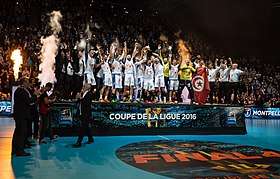


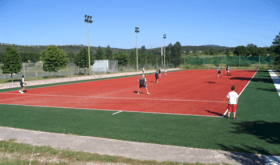
Baseball
| Club | League |
|---|---|
| Barracudas de Montpellier | D1 |
Basketball
| Club | League |
|---|---|
| BLMA | LFB EuroCup Women EuroLeague Women |
Beach soccer
| Club | League |
|---|---|
| Grande Motte Pyramide Beach Soccer | French Beach Football Championship |
| Montpellier Hérault Beach Soccer | French Beach Football Championship |
Football
| Club | League |
|---|---|
| AS Béziers | Ligue 2 |
| Montpellier HSC | Ligue 1 |
| Montpellier HSC (Women) | Division 1 Féminine |
| FC Sète 34 | N2 |
Handball
| Club | League |
|---|---|
| Montpellier Handball | Division 1 EHF Champions League |
Volley-ball
| Club | League |
|---|---|
| Béziers Volley (Women) | Ligue AF |
| Arago de Sète | Ligue AM |
| Montpellier Volley Université Club | Ligue AM |
Rugby
| Club | League |
|---|---|
| Rugby olympique agathois | Fédérale 1 |
| AS Béziers Hérault | Pro D2 |
| Montpellier Hérault Rugby | Top 14 European Rugby Champions Cup |
| Montpellier Hérault Rugby (Women) | Top 8 |
Water polo
| Club | League |
|---|---|
| Montpellier Water-Polo | Pro A |
Specific sports
There are several specific sports in the Hérault: the Tamburello (85% of French players) and the Water jousting.
Tourism
Popular tourist attractions
- 87 km of beaches
- 3 World Heritage Sites : Saint-Guilhem-le-Désert Abbey, Canal du Midi and Causses and Cévennes
- 2 Great sites in France : Saint-Guilhem-le-Désert and Gorges de l'Hérault and Cirque de Navacelles
- 1 Regional nature parks : Haut-Languedoc Regional Nature Park
- 2 Towns and Lands of Art and History : Pézenas and Lodève
- 3 villages listed in the Most Beautiful Villages of France : Saint-Guilhem-le-Désert, Olargues and Minerve
- 2 coastal resorts classified Heritage of the twentieth century : La Grande-Motte and Cap d'Agde
- 3 Spa town : Balaruc-les-Bains, Avène and Lamalou-les-Bains
- 19 marinas
- 541 sites classified or listed as historic monuments
Part of Cap d'Agde is a major nudist resort.
Cruising along the Canal du Midi and walking or cycling along the tow paths is a popular holiday option.
.jpg) Gambetta square in Pézenas
Gambetta square in Pézenas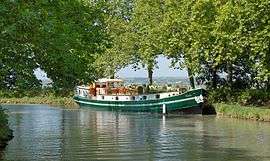 Houseboat on the Canal du Midi
Houseboat on the Canal du Midi Promenade du Peyrou in Montpellier
Promenade du Peyrou in Montpellier- View of Avène
 The "Lac du Salagou"
The "Lac du Salagou".jpg) Kayaking on the Orb
Kayaking on the Orb Crique de l'Anau in Sète
Crique de l'Anau in Sète
See also
References
- "Hérault - Deutsch-Übersetzung - Langenscheidt Französisch-Deutsch Wörterbuch" (in German and French). Langenscheidt. Retrieved 22 October 2018.
- Hoad, Phil (2017-03-13). "Montpellier in the spotlight: development mania in France's fastest-growing city". The Guardian. ISSN 0261-3077. Retrieved 2018-12-29.
- Nationale, Assemblée. "Assemblée nationale ~ Les députés, le vote de la loi, le Parlement français". Assemblée nationale.
- "Le SPLAF". splaf.free.fr.
External links
| Wikivoyage has a travel guide for Hérault. |
| Wikimedia Commons has media related to Hérault. |
- (in French) Prefecture website
- (in French) Conseil Général website
- (in English) Hérault's Official tourist office website
- (in English) Pézenas's Official tourist office website
- (in English) Montpellier's Official tourist office website
- (in English) Béziers's Official tourist office website
- (in English) Clermont-l'Hérault's Official tourist office website
- (in English) Étang de Thau's Official tourist office website
